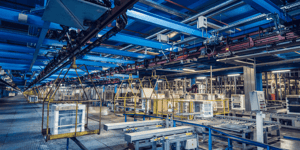
5 Companies That Revolutionized Their Manufacturing Operations
When manufacturing companies optimize their processes, it is a win-win proposition for the company and the consumer.
In addition, adoption of robotics can increase workplace safety for employees by converting high risk work tasks to these mechanical counterparts.
Here are some examples of pioneering companies that middle market companies can model to create cost reductions, process improvements and targeted revenue growth.
1. Tesla
The company is a leader in electric vehicle (EV) and clean energy solutions.
Optimization of Operations in Electric Vehicle Manufacturing.
Tesla has led the industry with high automation in its production lines, particularly in integrating cutting-edge robotics and artificial intelligence to streamline manufacturing processes. Tesla has also extended its battery technology to drop costs and enhance automobile efficiency. Tesla’s high degree of automation has drastically reduced the time and cost associated with vehicle assembly, allowing the company to increase production rapidly. Innovations such as introducing more efficient battery cells have not only enhanced vehicle performance but have also lowered the costs of EV’s, facilitating broader market adoption.
2. Boeing
One of the largest aerospace companies globally which manufactures commercial jetliners as well as defense, space, and security systems. Boeing is well known for its high standards in manufacturing efficiency and innovation.
Streamlining Operations with Lean Manufacturing and Smart Automation
Boeing has embraced lean manufacturing techniques and advanced automation in its production lines which includes using automated guided vehicles (AGVs) to move parts within its factories, automated drilling and riveting systems, and advanced robotics for assembly processes. Adoption of these technologies has led to significant improvements in Boeing’s production efficiency. Automation has reduced the time required for assembly processes by about 25% and lean manufacturing techniques have minimized waste and optimized the use of resources across Boeing’s production facilities. These advancements have contributed to maintaining high safety and quality standards, which are both critical in aerospace manufacturing.
3. Caterpillar
The company is a leading construction and mining equipment manufacturer known for its heavy machinery and engines. Caterpillar is focused on enhancing product quality and operational efficiency.
Enhancing Machinery Manufacturing with Automation and Connected Technologies
Caterpillar has embraced Industry 4.0 technologies, incorporating automation, machine learning, and loT connectivity in its manufacturing operations. The company uses autonomous robots for material handling and assembly, sensors, and data analytics to predict maintenance needs and to optimize production schedules. Automation has reduced labor costs and improved efficiency and safety by taking over dangerous tasks previously handled by humans. The connectivity solutions have enabled real-time monitoring and adjustments, leading to better product quality and faster response times to market changes.
4. Intel
A semiconductor industry leader which manufactures microprocessors central to many computing devices. Intel is well known for its technological innovations and large-scale manufacturing capabilities.
Maximizing Efficiency with Advanced Chip Manufacturing
Intel has pioneered the development of next-generation microprocessors using advanced manufacturing techniques, including photolithography and 3D transistor technology. The company has invested heavily in the state-of-the-art fabrication facilities which clean rooms and automated assembly lines to control the manufacturing environment precisely. These investments and innovations have allowed Intel to produce reduced, more powerful, and energy-efficient chips. This progress has kept Intel at the forefront of the semiconductor industry, maintaining its competitive edge and responding effectively to the rapidly evolving demands of the global markets.
5. John Deere
The company stands as a preeminent manufacturer of agricultural machinery, dedicated to leveraging technological advancements to enhance farm productivity and promote sustainability.
Maximizing Efficiency with Precision Agriculture in Manufacturing
John Deere has incorporated GPS tracking, loT connectivity, and data analytics, to facilitate precision farming which allow for better resource management, optimizing everything from seeding to harvesting. These technologies have enabled farmers to significantly increase efficiency and reduce waste, leading to better yields and lower environmental impact. These manufacturing practices have reinforced the company’s leadership in the farming sector, proposing cutting-edge resolutions catering to current farmer’s requirements.
Key Takeaways
In conclusion, the innovative approaches employed by Tesla, Boeing, Caterpillar, Intel, and John Deere demonstrate how strategic optimization in manufacturing can drive significant improvements in efficiency, safety, and market competitiveness.
For middle market companies aiming to enhance their own processes, these examples provide valuable insights as embracing similar strategies can lead to increased productivity, revenue growth and cost reductions, ultimately benefiting both the company and its customers.
LGT works with middle-market manufacturers to identify opportunities for process improvement, operational efficiency, and sustainable growth. Contact us to learn how we can help turn insight into action.
To learn more about LGT and how we can serve you, contact us here.


